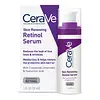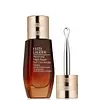What's inside
What's inside
 Key Ingredients
Key Ingredients

 Benefits
Benefits

 Concerns
Concerns

 Ingredients Side-by-side
Ingredients Side-by-side

Water
Skin ConditioningGlycerin
HumectantCaprylic/Capric Triglyceride
MaskingPotassium Cetyl Phosphate
EmulsifyingHydrogenated Palm Glycerides
EmollientPolysorbate 20
EmulsifyingPEG-40 Stearate
EmulsifyingCyclopentasiloxane
EmollientHydroxyethylcellulose
Emulsion StabilisingPotassium Phosphate
BufferingCeramide NP
Skin ConditioningCeramide AP
Skin ConditioningCeramide EOP
Skin ConditioningCarbomer
Emulsion StabilisingNiacinamide
SmoothingIsoceteth-10
EmulsifyingDimethicone/Vinyl Dimethicone Crosspolymer
Skin ConditioningTriethanolamine
BufferingCetearyl Alcohol
EmollientBehentrimonium Methosulfate
Cichorium Intybus Root Extract
MaskingLecithin
EmollientRetinol
Skin ConditioningSilica
AbrasiveSodium Lauroyl Lactylate
EmulsifyingCholesterol
EmollientPhenoxyethanol
PreservativeTocopherol
AntioxidantAlcohol
AntimicrobialHydroxyacetophenone
AntioxidantCitric Acid
BufferingHydrolyzed Hyaluronic Acid
HumectantPentylene Glycol
Skin ConditioningXanthan Gum
EmulsifyingPhytosphingosine
Skin ConditioningButyrospermum Parkii Butter
Skin ConditioningEthylhexylglycerin
Skin ConditioningWater, Glycerin, Caprylic/Capric Triglyceride, Potassium Cetyl Phosphate, Hydrogenated Palm Glycerides, Polysorbate 20, PEG-40 Stearate, Cyclopentasiloxane, Hydroxyethylcellulose, Potassium Phosphate, Ceramide NP, Ceramide AP, Ceramide EOP, Carbomer, Niacinamide, Isoceteth-10, Dimethicone/Vinyl Dimethicone Crosspolymer, Triethanolamine, Cetearyl Alcohol, Behentrimonium Methosulfate, Cichorium Intybus Root Extract, Lecithin, Retinol, Silica, Sodium Lauroyl Lactylate, Cholesterol, Phenoxyethanol, Tocopherol, Alcohol, Hydroxyacetophenone, Citric Acid, Hydrolyzed Hyaluronic Acid, Pentylene Glycol, Xanthan Gum, Phytosphingosine, Butyrospermum Parkii Butter, Ethylhexylglycerin
Water
Skin ConditioningDimethicone
EmollientBifida Ferment Lysate
Skin ConditioningIsohexadecane
EmollientGlycerin
HumectantButylene Glycol
HumectantBis-PEG-18 Methyl Ether Dimethyl Silane
EmollientPEG-10 Dimethicone
Skin ConditioningDisteardimonium Hectorite
StabilisingIsopropyl Isostearate
EmollientPPG-15 Stearyl Ether
EmollientSucrose
HumectantTrehalose
HumectantAdansonia Digitata Seed Extract
Skin ConditioningTripeptide-32
Skin ConditioningYeast Extract
Skin ConditioningSodium Hyaluronate
HumectantLactobacillus Ferment
Skin ConditioningAlgae Extract
EmollientSodium Rna
Skin ConditioningHydrolyzed Algin
Caffeine
Skin ConditioningHydroxyethyl Urea
HumectantAminopropyl Ascorbyl Phosphate
AntioxidantCucumis Sativus Fruit Extract
EmollientAnthemis Nobilis Flower Extract
MaskingHordeum Vulgare Extract
EmollientSilybum Marianum Extract
Skin ConditioningGlycine Soja Seed Extract
Skin ConditioningCamelina Sativa Seed Oil
Skin ConditioningSorbitol
HumectantBetula Alba Bud Extract
Skin ConditioningScutellaria Baicalensis Root Extract
AstringentMorus Bombycis Root Extract
Skin ConditioningPoria Cocos Sclerotium Extract
AstringentTocopheryl Acetate
AntioxidantPropylene Glycol Dicaprate
EmollientSodium Polyaspartate
HumectantHydrogenated Lecithin
EmulsifyingPhytosphingosine
Skin ConditioningEthylhexylglycerin
Skin ConditioningPolysilicone-11
Isododecane
EmollientHelianthus Annuus Seed Extract
Skin ConditioningPolyethylene
AbrasivePropylene Carbonate
SolventPolyacrylate Crosspolymer-6
Emulsion StabilisingLecithin
EmollientGlucose
HumectantFructose
HumectantT-Butyl Alcohol
PerfumingDisodium EDTA
BHT
AntioxidantHydroxyacetophenone
AntioxidantSodium Dehydroacetate
PreservativePotassium Sorbate
PreservativePhenoxyethanol
PreservativeCI 77491
Cosmetic ColorantWater, Dimethicone, Bifida Ferment Lysate, Isohexadecane, Glycerin, Butylene Glycol, Bis-PEG-18 Methyl Ether Dimethyl Silane, PEG-10 Dimethicone, Disteardimonium Hectorite, Isopropyl Isostearate, PPG-15 Stearyl Ether, Sucrose, Trehalose, Adansonia Digitata Seed Extract, Tripeptide-32, Yeast Extract, Sodium Hyaluronate, Lactobacillus Ferment, Algae Extract, Sodium Rna, Hydrolyzed Algin, Caffeine, Hydroxyethyl Urea, Aminopropyl Ascorbyl Phosphate, Cucumis Sativus Fruit Extract, Anthemis Nobilis Flower Extract, Hordeum Vulgare Extract, Silybum Marianum Extract, Glycine Soja Seed Extract, Camelina Sativa Seed Oil, Sorbitol, Betula Alba Bud Extract, Scutellaria Baicalensis Root Extract, Morus Bombycis Root Extract, Poria Cocos Sclerotium Extract, Tocopheryl Acetate, Propylene Glycol Dicaprate, Sodium Polyaspartate, Hydrogenated Lecithin, Phytosphingosine, Ethylhexylglycerin, Polysilicone-11, Isododecane, Helianthus Annuus Seed Extract, Polyethylene, Propylene Carbonate, Polyacrylate Crosspolymer-6, Lecithin, Glucose, Fructose, T-Butyl Alcohol, Disodium EDTA, BHT, Hydroxyacetophenone, Sodium Dehydroacetate, Potassium Sorbate, Phenoxyethanol, CI 77491
 Reviews
Reviews

Ingredients Explained
These ingredients are found in both products.
Ingredients higher up in an ingredient list are typically present in a larger amount.
Ethylhexylglycerin (we can't pronounce this either) is commonly used as a preservative and skin softener. It is derived from glyceryl.
You might see Ethylhexylglycerin often paired with other preservatives such as phenoxyethanol. Ethylhexylglycerin has been found to increase the effectiveness of these other preservatives.
Glycerin is already naturally found in your skin. It helps moisturize and protect your skin.
A study from 2016 found glycerin to be more effective as a humectant than AHAs and hyaluronic acid.
As a humectant, it helps the skin stay hydrated by pulling moisture to your skin. The low molecular weight of glycerin allows it to pull moisture into the deeper layers of your skin.
Hydrated skin improves your skin barrier; Your skin barrier helps protect against irritants and bacteria.
Glycerin has also been found to have antimicrobial and antiviral properties. Due to these properties, glycerin is often used in wound and burn treatments.
In cosmetics, glycerin is usually derived from plants such as soybean or palm. However, it can also be sourced from animals, such as tallow or animal fat.
This ingredient is organic, colorless, odorless, and non-toxic.
Glycerin is the name for this ingredient in American English. British English uses Glycerol/Glycerine.
Learn more about GlycerinHydroxyacetophenone is antioxidant with skin conditioning and soothing properties. It also boosts the efficiency of preservatives.
This ingredient is not irritating or sensitizing.
Lecithin is a term for a group of substances found in the cell membranes of plants, animals, and humans. They are made up of mixture of phospholipids.
This ingredient has emollient and emulsifying properties.
As an emollient, lecithen helps soften the skin and creates a barrier to keep moisture in.
As an emulsifier, it also helps prevent water and oil ingredients from separating. Lecithin can also help ingredients be better absorbed by the skin.
This is because the phospholipids in lecithin produce liposomes. Liposomes help other ingredients get through the skin barrier.
Depending on the source of this ingredient, lecithin may not be fungal acne safe. This is because some sources of lecithin come from soybean oil, which may feed the malassezia yeast that feeds fungal acne.
We recommend reaching out to the brand you are purchasing from to inquire about the source of their lecithin.
Some other names for this ingredient include soy lecithin and deoiled soy lecithin.
Learn more about LecithinPhenoxyethanol is a preservative that has germicide, antimicrobial, and aromatic properties. Studies show that phenoxyethanol can prevent microbial growth. By itself, it has a scent that is similar to that of a rose.
It's often used in formulations along with Caprylyl Glycol to preserve the shelf life of products.
Phytosphingosine is a phospholipid naturally found in our skin as a building block for ceramides.. It helps moisturize, soothe, and protect skin.
Phytosphingosine contributes to your skin's natural moisturizing factor (NMF). The NMF is responsible for hydration, a strong barrier, and plasticity. Our NMF decreases with age. Increasing NMF leads to more healthy and hydrated skin.
Studies show products formulated with NMF ingredients help strengthen our skin's barrier. Having a healthy skin barrier reduces irritation and increases hydration. Our skin barrier is responsible for having plump and firm skin. It also helps protect our skin against infection, allergies, and inflammation.
Fun fact: Phytosphingosine is abundant in plants and fungi.
More ingredients that help boost collagen in skin:
Learn more about PhytosphingosineWater. It's the most common cosmetic ingredient of all. You'll usually see it at the top of ingredient lists, meaning that it makes up the largest part of the product.
So why is it so popular? Water most often acts as a solvent - this means that it helps dissolve other ingredients into the formulation.
You'll also recognize water as that liquid we all need to stay alive. If you see this, drink a glass of water. Stay hydrated!
Learn more about Water